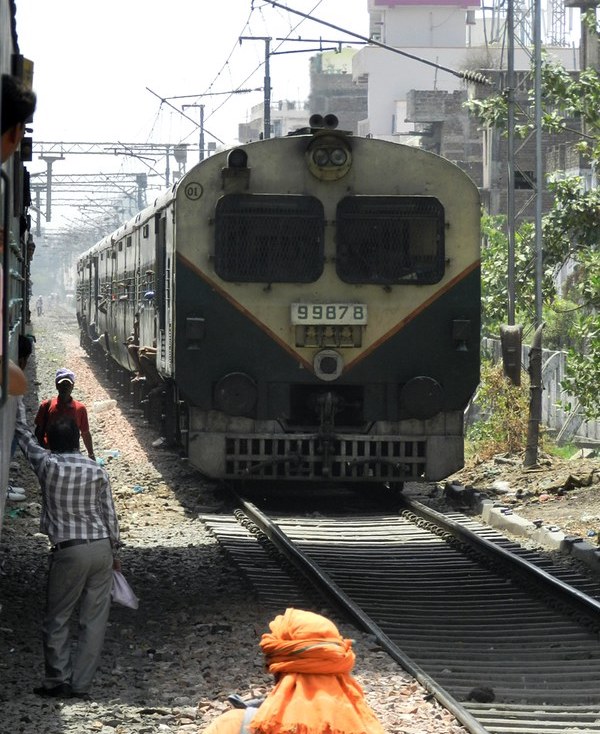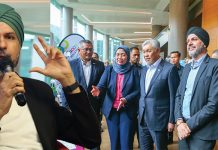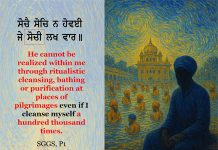
By Gurmukh Singh | Opinion |
“For this purpose was I born: To spread righteous living, to raise the saintly people and to destroy the evil doers.” (Guru Gobind Singh, Bachittar Natak)
Gobind Das, also known as Gobind Rai before Vaisakhi 1699, was the only child of Ninth Nanak, Guru Tegh Bahadur and Mata Gujri. He was born at Patna in Bihar, on 18 December 1661 (see end-note about the Guru’s birth date).
He spent the first few years of his life at Patna and attracted much local attention and affection from Hindu and Muslim communities alike due to his exceptional qualities. Muslim saints like Bhikhan Shah of Ghuram and Araf Din of Lakhnaur came to see him and were impressed by his wisdom. A Hindu saint, Shiv Dutt, and the local Raja Fateh Chand of Patna and his wife became his devotees.
The point to note is that from his childhood until the conclusion of his mission on this earth, the Guru’s treatment of diverse communities was above religious and social divides. He treated all as “Manas ki jaat” (One Human race or community). He loved all and attracted saintly people from all communities but resisted oppression regardless of the religio-social background of the aggressor or the odds against him.
As he grew up at Patna, he was aware of the prolonged preaching tours of his father, Guru Tegh Bahadur, to distant places in northern and eastern Indian sub-continent to revive the Sangats of Guru Nanak.
In year 1670, the Guru family started the long journey of over 1,000 miles to Punjab, staying in many towns on the way. Gobind Das was liked and admired by all. The family reached the village of Bakala in Punjab and in 1672 moved to Chakk Nanaki, now known as Anandpur Sahib. The land had been purchased from the ruler of Bilaspur (Kahlur) by Guru Tegh Bahadur in 1665. Thousands came to see young Gobind Das.
His tutors included Sahib Chand, and Persian scholar Qazi Pir Mohammad. He also received training in military skills and horse riding from his father, Guru Tegh Bahadur, the Master of the Sword, who had kept up his interest in weapons training and hunting since the battles of his father, Guru Hargobind. As Gobind grew up, he excelled in poetry, music and martial arts and was peerless in archery and horse-riding.
From the age of nine years, he accompanied his father during the Panjab and Bangar Desh tours. At the age of 14 years he was fully aware of the plight of the Brahmins of northern India and Kashmir when they came to seek Guru Tegh Bahadur’s help against Aurungzeb’s religious persecution. Gobind Das played a key role in Guru Tegh Bahadur’s decision to confront Aurungzeb with his cruelty.
Guru Tegh Bahadur’s subsequent unique martyrdom would awaken the people of India to resist foreign invasions and state terrorism under the lead of the Guru’s Khalsa.
That was the position of strength based on the country-wide network of Sangats, which the Guru inherited from Guru Nanak to Guru Tegh Bahadur. The foundation on which Khalsa institutions were built by a succession of Guru-persons was laid deep by Guru Nanak. Now the Guru Jot-Jugat resided in him to complete the Guru tuition period from 1469 to 1708.
Gobind Das was anointed Guru on 8 July 1675 before Guru Tegh Bahadur set off for Delhi to confront Aurungzeb with his religious zealotry. His own evidence leaves no doubt that Aurungzeb was in Delhi when Guru Tegh Bahadur and his three Sikhs, Matti Das, Bhai Dyala and Satti Das. were martyred.
He moved to Paonta on the bank of the river Yamuna and stayed there till 1685. There, many reputable poets came to him. Some literature attributed to the Guru was also written there.
PEN BEFORE THE SWORD
The strategy followed was the same as that of the earlier Gurus starting with Guru Nanak. He energised a downtrodden people by reminding them of their own heritage by making available to them in common language the Vedic literature (ancient Hindu literature) about the great deeds of their own Indic folk heroes: the mythological gods and goddesses, who (in their belief system) were the forces of good who had fought and destroyed the forces of evil. Encouraged by him, scholars and poets flocked to him to write poetry and literature in the ordinary language of the people. This was a sacrilege for the Brahmin because, hitherto, Vedic literature in Sanskrit had been monopolized and exploited for personal gain by the Brahmin to maintain his social position at the top.
He specifically denounced the Brahmin priestly class, the Bipran, who misled and exploited the ordinary people and were the main cause of India’s weak position against the onslaught of Islamic invaders. They were held responsible for the divided Indian society and the subjugation of the people of sub-continent for centuries.
The literature associated with Guru Gobind Singh should be seen in its proper context as above, as a means of awakening the people to their own past which showed the triumph of good over evil. However, he made it clear even in that literature that his own path did not follow the old ways and that he was the servant of none other than the One Supreme Timeless Unborn Creator Being (also described in Jaap Sahib as The Self-Aware Unlimited Energy capable of changing from Potential (Achal) state to manifest state at Own Will.)
Yet, in another sense, the Vedic literature made available in common language exposed the ancient myth and lore to the scrutiny of the more discerning. Many decided to join the expanding ranks of the Guru’s mar-jeevra (reborn) Khalsa. From Guru Nanak Sahib onwards, the Guru Jote (divine Light) warned that Sikhi demanded one’s ego-centric head! Sikhi was a challenging and difficult path of love and sacrifice to follow. A Path of inner detachment while remaining fully participative in the Creator’s world-play. It was about social activism and it unequivocally rejected the opt-out lifestyle of the Indic systems.
Like work-in-progress, we shall continue at our own pedestrian pace to comprehend and analyse the literary contribution of Guru Gobind Singh. In my view, arrogant positions for and against the literary works associated with the Guru, miss the point.
ARMED DEFENCE
After some years at Paonta, where literature was written and collated to awaken the dormant spirit of the people, followed the battle of Bhangani forced on the Guru by the treacherous hill rajas. The Guru moved back to Anandpur for the next phase. Time had come to take up the sword as the last resort to oppose oppression and foreign invasions.
Guru Gobind Singh fought 14 battles between 1688 (Battle of Bhangani) and 1705 (Battle of Muktsar) against impossible odds: the combined forces of the tyrannical Mughal rulers and their cowardly subordinate rajas and vassals. The epic battles of Anandpur and Chamkaur are memorable in the history of warfare.

In accordance with Guru Nanak’s pre-condition for treading the path of Sikhi (Je tao prem khelan ka chao), as Tenth Nanak, he put his Khalsa through the mar-jeevra (reborn) Amrit initiation test on the Vaisakhi Day in 1699. He taught them the Nash doctrine to ensure complete break from the divisive ways of the wily Brahmin which had enslaved the ordinary people of the Indian subcontinent for centuries.
After Vaisakhi 1699, events took place in quick succession. With reports reaching the Mughal Darbar, came the confrontation. The siege of Anandpur; the epic battle of Chamkaur and the martyrdom of the two older Sahibzaaday; on to Macchiwara through thorny bushes from Chamkaur, alone barefooted with a sword in hand; the martyrdom of the two younger Sahibzaaday as ordered by the Nawab of Sirhind; the remarkable journey in disguise as Uch-da-Pir; the regrouping of the Khalsa army around the Guru to deliver a crushing blow to the pursuing Mughal forces at the last battle of Muktsar and on to Nanded (Hajoor Sahib) after some months stay at Damdama Sahib.
In the succession battles for the throne after Aurungzeb, prince Muazzam, the most moderate of his sons, sought the Guru’s help through the mediation of the Guru’s devotee scholar, Bhai Nand Lal. Help was given and appreciated; but once he became emperor as Bahadur Shah, probably due to pressure from the religious fanatics around him and his weak position as a new emperor, he reneged on his promise to punish the powerful Nawab of Sirhind who had ordered the martyrdom of the younger Sahibzaaday. He was probably implicated in the treacherous stabbing of the Guru while resting. The assassin himself was killed by the Guru.
As pre-ordained, the teaching mission of Guru Nanak Jot in ten human forms was nearing completion. Baba Banda Singh Bahadur was given his final instructions. He was to follow the Guru’s own example as the servant-Commander of the Khalsa army and continue with the Guru’s nation-building mission towards a sovereign Khalsa state in which all enjoyed equal freedoms and rights.
Guru Gobind Singh passed on the Gurgaddi to Guru Granth Sahib. And so, having completed own mission as Nanak Tenth, the Guru departed for Sach Khand a on 7 October 1708.
Guru Gobind Singh was a living martyr, a Sarbans Daani, who sacrificed his whole family to accomplish his mission which he stated as:
“For this purpose was I born: To spread righteous living, to raise the saintly people and to destroy the evil doers.” (Guru Gobind Singh, Bachittar Natak).
Note about Guru Gobind Singh’s Parkash (birth) date:
Sikh historiographers have shown beyond doubt that birth dates of some Gurus, starting with Guru Nanak Sahib, are not the same as the dates on which they are celebrated. As confirmed by contemporary sources, Gobind Das was born on Samat 1718 Pokh Massay Sudi Saptmi on Budhwar (Wednesday). Converted to Julian Calendar, that date is 18 December 1661. The day of the week was Wednesday on that date. (Guru Kian Sakhian, Sakhi 18 and Bhatt Vahi Purabi Dakhni).

Gurmukh Singh OBE, a retired UK senior civil servant, chairs the Advisory Board of The Sikh Missionary Society UK. Email: sewauk2005@yahoo.co.uk. Click here for more details on the author.
* This is the opinion of the writer, organisation or publication and does not necessarily represent the views of Asia Samachar.
RELATED STORY:
Three Lessons for World Religions from the martyrdom of Guru Tegh Bahadur (Asia Samachar, 22 Nov 2022)
Guru Gobind Singh: The Man Non-Pareil (Asia Samachar, 22 Nov 2022)
ASIA SAMACHAR is an online newspaper for Sikhs / Punjabis in Southeast Asia and beyond.Facebook | WhatsApp +6017-335-1399 | Email: editor@asiasamachar.com | Twitter | Instagram | Obituary announcements, click here

































